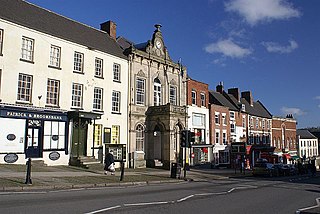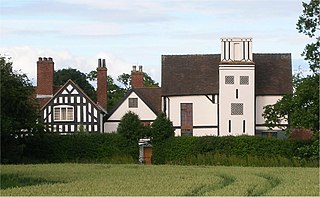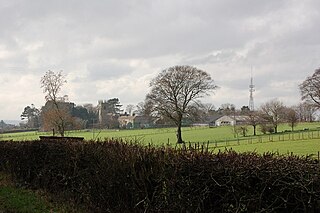
Somersal Herbert Hall is a privately owned timber-framed 16th-century country house at Somersal Herbert, near Ashbourne, Derbyshire, in England. It is a Grade I listed building. [1]

Timber framing and "post-and-beam" construction are traditional methods of building with heavy timbers, creating structures using squared-off and carefully fitted and joined timbers with joints secured by large wooden pegs. It is commonplace in wooden buildings from the 19th century and earlier. If the structural frame of load-bearing timber is left exposed on the exterior of the building it may be referred to as half-timbered, and in many cases the infill between timbers will be used for decorative effect. The country most known for this kind of architecture is Germany. Timber framed houses are spread all over the country except in the southeast.

Somersal Herbert is a hamlet and civil parish in Derbyshire, England, 2 miles northeast of Doveridge. Somersal Herbert Hall was built c.1564, incorporating an earlier building from c.1500, and is a Grade I listed building. Hill Somersal and Potter Somersal are minor settlements within 1 mile.

Ashbourne is a market town in the Derbyshire Dales, England. It has a population of 7,112. It contains many historical buildings and many independent shops and is famous for its historic annual Shrovetide football match.
The Fitzherbert family came to Somersal in the 13th century when the estate was acquired by Thomas Fitzherbert, second son of Sir William Fitzherbert of Norbury. The present timber-framed house was built by John Fitzherbert on the site of an earlier manor house in 1564. The entrance front at the south and other parts were encased in brick in 1712, when the property was enlarged.
The Somersal line of the Fitzherbert family was extinct on the death of Richard Fitzherbert in 1803. The estate was initially sold in 1806 outside the family but was later repurchased by his cousin Alleyne Fitzherbert, 1st Baron St Helens, younger brother of Sir William Fitzherbert, Bt of Tissington. He lent it in 1808 for life to cousins of his, the novelist Frances Jacson (1754–1842) and her sister Maria Jacson (1755–1829), a writer on botany and gardening, who were in financial straits caused by a spendthrift brother. [2] In about 1850 Sir Henry Fitzherbert, Bt enlarged the house by the addition of a north wing for his second son Richard who was in occupation of the house in 1881. His son Anthony emigrated to New Zealand and the estate was sold.

Tissington Hall is an early 17th-century Jacobean mansion house in Tissington, near Ashbourne, Derbyshire. It is a Grade II* listed building.
Frances Margaretta Jacson was an English novelist. Her work shows a strong moral purpose and insight into relationships and marriages.
It was modernised and restored in 1899; further restoration work was carried out in 2004.














